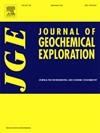滇西腾冲地块新起WSn多金属矿床地质年代学
IF 3.4
2区 地球科学
Q1 GEOCHEMISTRY & GEOPHYSICS
引用次数: 0
摘要
新岐是三江地区腾冲锡多金属成矿带中最重要的钨锡多金属矿床之一。然而,钨锡矿床的成矿年龄和潜在母岩花岗岩尚未确定。本文将新起成矿过程划分为5个阶段:钾的阶段(I期)、钠阶段(第二阶段),云英岩阶段(第三阶段),quartz-cassiterite-wolframite阶段(四期),和quartz-cassiterite-sulfide阶段(V)阶段。UPb约会的锡石和钨锰铁矿从石英脉矿石中提取阶段IV和V收益率一致的马65.4±1岁和64.65±0.66 Ma,分别表明WSn矿化发生在晚白垩世和密切相关的印度和欧亚板块之间的碰撞。综合前人对腾冲地块钨锡成矿年龄的研究结果,认为该区钨锡成矿与花岗岩密切相关,主要发生于早白垩世至古近纪。新齐WSn矿化年龄与古永二长花岗岩形成年龄(66.30±0.23 Ma)一致,但比新齐花岗斑岩(51.66±0.21 Ma)老约15 Ma。该相关性与二长花岗岩的低氧逸度(△FMQ值在- 2.54 ~ 1.50之间)相结合,表明二长花岗岩在锡富集中起着关键作用,是新齐WSn成矿的母岩。母型二长花岗岩的εHf(t)值较低,范围为- 10.94 ~ - 19.54,表明成矿岩浆可能来源于古地壳,未受地幔污染。在前人研究的基础上,提出腾冲地区存在富锡陆壳,该陆壳经历了一系列特定的碰撞造山事件,形成了花岗岩,并在腾冲地块形成了相应的锡矿化。本文章由计算机程序翻译,如有差异,请以英文原文为准。
Geology and geochronology of the Xinqi WSn polymetallic deposit in the Tengchong block, western Yunnan, China
Xinqi is one of the most significant tungsten‑tin polymetallic deposits in the Tengchong tin polymetallic metallogenic belt, Sanjiang area. However, the age of the mineralization and the potential parental granite for tungsten‑tin (W![]() Sn) deposits have not yet been constrained. In this study, the ore-forming process at Xinqi is categorized into five stages: potassic stage (Stage I), sodium stage (Stage II), greisen stage (Stage III), quartz-cassiterite-wolframite stage (Stage IV), and quartz-cassiterite-sulfide stage (Stage V). U
Sn) deposits have not yet been constrained. In this study, the ore-forming process at Xinqi is categorized into five stages: potassic stage (Stage I), sodium stage (Stage II), greisen stage (Stage III), quartz-cassiterite-wolframite stage (Stage IV), and quartz-cassiterite-sulfide stage (Stage V). U![]() Pb dating of cassiterite and wolframite extracted from quartz vein ore in stages IV and V yields consistent ages of 65.4 ± 1 Ma and 64.65 ± 0.66 Ma, respectively, indicating that W
Pb dating of cassiterite and wolframite extracted from quartz vein ore in stages IV and V yields consistent ages of 65.4 ± 1 Ma and 64.65 ± 0.66 Ma, respectively, indicating that W![]() Sn mineralization occurred during the Late Cretaceous and is closely associated with the collision between the Indian and Eurasian plates. Integrating this data with previous findings on W
Sn mineralization occurred during the Late Cretaceous and is closely associated with the collision between the Indian and Eurasian plates. Integrating this data with previous findings on W![]() Sn mineralization ages in the Tengchong block suggests that tungsten‑tin mineralization in this area is closely linked to granite, predominantly occurring from the Early Cretaceous to the Paleogene. The ages of W
Sn mineralization ages in the Tengchong block suggests that tungsten‑tin mineralization in this area is closely linked to granite, predominantly occurring from the Early Cretaceous to the Paleogene. The ages of W![]() Sn mineralization at Xinqi align with the formation age of Guyong monzogranite (66.30 ± 0.23 Ma) but are approximately 15 Ma older than the Xinqi granite porphyry (51.66 ± 0.21 Ma). This correlation, along with the low oxygen fugacity of the monzogranite (the value of △FMQ from −2.54 to 1.50), indicates that the monzogranite plays a crucial role in tin enrichment and serves as the parental granite for W
Sn mineralization at Xinqi align with the formation age of Guyong monzogranite (66.30 ± 0.23 Ma) but are approximately 15 Ma older than the Xinqi granite porphyry (51.66 ± 0.21 Ma). This correlation, along with the low oxygen fugacity of the monzogranite (the value of △FMQ from −2.54 to 1.50), indicates that the monzogranite plays a crucial role in tin enrichment and serves as the parental granite for W![]() Sn mineralization at Xinqi. The parental monzogranite exhibits low εHf(t) values ranging from −10.94 to −19.54, suggesting that the ore-forming magma likely derived from ancient crust without mantle contamination. Furthermore, based on previous studies, we propose that a tin-rich continental crust exists in the Tengchong area, which has undergone a series of specific collisional orogenic events that led to the formation of granite and the associated tin mineralization in the Tengchong block.
Sn mineralization at Xinqi. The parental monzogranite exhibits low εHf(t) values ranging from −10.94 to −19.54, suggesting that the ore-forming magma likely derived from ancient crust without mantle contamination. Furthermore, based on previous studies, we propose that a tin-rich continental crust exists in the Tengchong area, which has undergone a series of specific collisional orogenic events that led to the formation of granite and the associated tin mineralization in the Tengchong block.
求助全文
通过发布文献求助,成功后即可免费获取论文全文。
去求助
来源期刊

Journal of Geochemical Exploration
地学-地球化学与地球物理
CiteScore
7.40
自引率
7.70%
发文量
148
审稿时长
8.1 months
期刊介绍:
Journal of Geochemical Exploration is mostly dedicated to publication of original studies in exploration and environmental geochemistry and related topics.
Contributions considered of prevalent interest for the journal include researches based on the application of innovative methods to:
define the genesis and the evolution of mineral deposits including transfer of elements in large-scale mineralized areas.
analyze complex systems at the boundaries between bio-geochemistry, metal transport and mineral accumulation.
evaluate effects of historical mining activities on the surface environment.
trace pollutant sources and define their fate and transport models in the near-surface and surface environments involving solid, fluid and aerial matrices.
assess and quantify natural and technogenic radioactivity in the environment.
determine geochemical anomalies and set baseline reference values using compositional data analysis, multivariate statistics and geo-spatial analysis.
assess the impacts of anthropogenic contamination on ecosystems and human health at local and regional scale to prioritize and classify risks through deterministic and stochastic approaches.
Papers dedicated to the presentation of newly developed methods in analytical geochemistry to be applied in the field or in laboratory are also within the topics of interest for the journal.
 求助内容:
求助内容: 应助结果提醒方式:
应助结果提醒方式:


